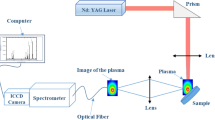Abstract
In this work, the Stark effect is shown to be mainly responsible for wrong elemental allocation by automated laser-induced breakdown spectroscopy (LIBS) software solutions. Due to broadening and shift of an elemental emission line affected by the Stark effect, its measured spectral position might interfere with the line position of several other elements. The micro-plasma is generated by focusing a frequency-doubled 200 mJ pulsed Nd/YAG laser on an aluminum target and furthermore on a brass sample in air at atmospheric pressure. After laser pulse excitation, we have measured the temporal evolution of the Al(II) ion line at 281.6 nm (4s 1 S-3p 1 P) during the decay of the laser-induced plasma. Depending on laser pulse power, the center of the measured line is red-shifted by 130 pm (490 GHz) with respect to the exact line position. In this case, the well-known spectral line positions of two moderate and strong lines of other elements coincide with the actual shifted position of the Al(II) line. Consequently, a time-resolving software analysis can lead to an elemental misinterpretation. To avoid a wrong interpretation of LIBS spectra in automated analysis software for a given LIBS system, we recommend using larger gate delays incorporating Stark broadening parameters and using a range of tolerance, which is non-symmetric around the measured line center. These suggestions may help to improve time-resolving LIBS software promising a smaller probability of wrong elemental identification and making LIBS more attractive for industrial applications.

Misinterpretation of a LIBS analysis due to the temporal spectral evolution of a red-shifted aluminum line inclenced by the Stark effect









Similar content being viewed by others
References
Noll R, Bette H, Brysch A, Kraushaar M, Monch I, Peter L, Sturm V (2001) Spectrochim Acta B 57:637–649
Kearton B, Mattley Y (2008) Nat Photonics 2:537–540
Cristoforetti G, Legnaioli S, Palleschi V, Salvetti A, Tognoni E, Benedetti PA, Brioschi F, Ferrario F (2006) J Analyt At Spectrom 21:697–702
Vadillo JM, Laserna JJ (2004) Spectrochim Acta B 59:147–161
Lithgow GA, Robinson AL, Buckley SG (2004) Atmos Environ 38:3319–3328
Wagner C, Ewald J, Ankerhold G, Kohns P (2009) Proceedings SPIE Optical Metrology – Optical Measurement Systems for Industrial Inspection, 7389:paper no 81
Panne U, Neuhauser RE, Haisch C, Fink H, Niessner R (2003) Appl Spectrosc 56:375–380
Kohns P, Zhou P, Schulz H, Störmann R, Heidrich K (1998) In: Waidelich W (ed) Laser in medicine, Springer Berlin
NIST Atomic Spectra, National Institute of Standards and Technology Standard Reference Data Base #78, Version 3 (2009) http://www.nist.gov/pml/data/asd.cfm
Kaufmann V, Hagan L (1997) J Opt Soc Am 69:232–239
Griem HR (2005) Principles of plasma spectroscopy. Cambridge University Press
Aguilera JA, Aragón C (2007) Spectrochima Acta B 62:378–385
Mohamed WTY (2007) Prog Phys 2:87–92
Demtröder W (1996) Laser spectroscopy. Springer-Verlag
Colón C, Hatem G, Verdugo E, Ruiz P, Campos J (1993) J Appl Phys 73:4752–4758
Acknowledgment
This work was supported by the "Arbeitsgemeinschaft industrieller Forschung" (AiF Berlin, Germany), project number PRO INNO II KF0548801DA7.
Author information
Authors and Affiliations
Corresponding author
Additional information
Published in the special issue Laser-Induced Breakdown Spectroscopy with Guest Editors Jagdish P. Singh, Jose Almirall, Mohamad Sabsabi, and Andrzej Miziolek.
Rights and permissions
About this article
Cite this article
Hübert, W., Ankerhold, G. Elemental misinterpretation in automated analysis of LIBS spectra. Anal Bioanal Chem 400, 3273–3278 (2011). https://doi.org/10.1007/s00216-011-4793-x
Received:
Revised:
Accepted:
Published:
Issue Date:
DOI: https://doi.org/10.1007/s00216-011-4793-x




